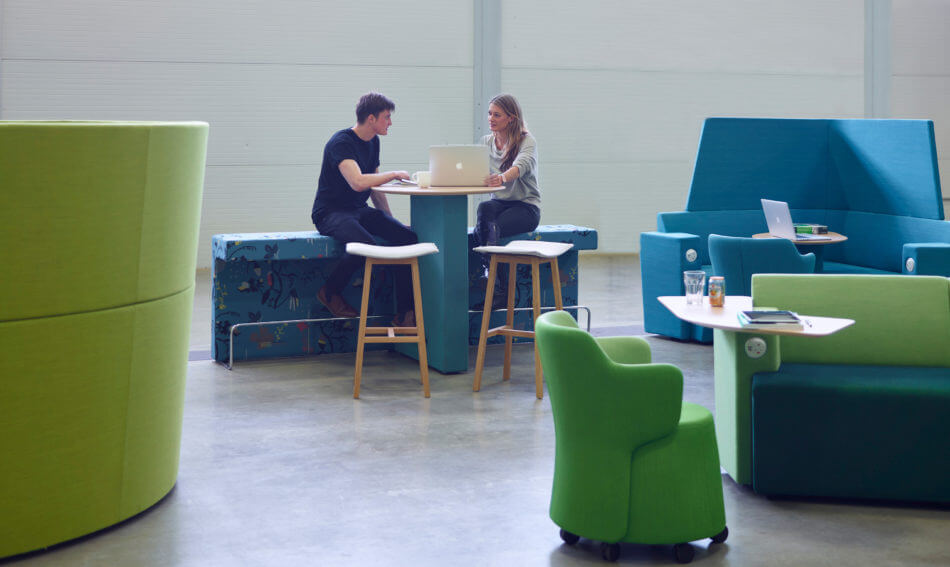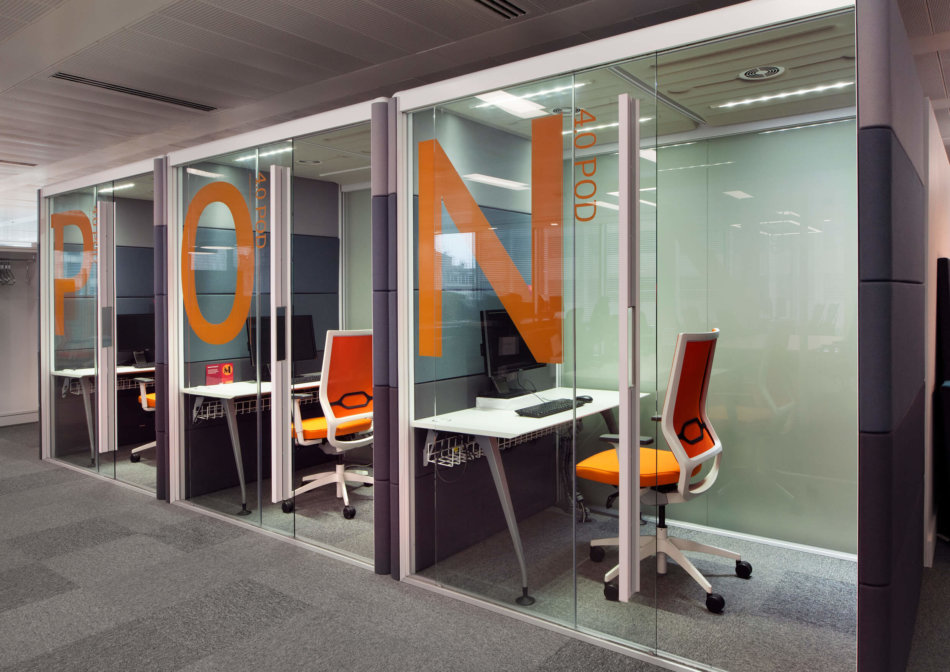In September 2018, Steelcase Inc. announced it acquired Orangebox Group Limited, a UK-based designer and manufacturer of furniture for the changing workplace, the latest in a rapid expansion of innovative products designed for the new ways people work.
So, how innovative furniture maker Orangebox led the way to work beyond the desk?
It was the summer of 2002 — six years after IBM’s Simon Personal Communicator, the first smartphone, debuted — when Orangebox was born in the village of Hengoed, South Wales, U.K., far away from the disruption occurring in places like Silicon Valley where emerging ways of work were happening. It was the same year BlackBerrys were hitting the market but five years before the Apple iPhone ushered in new levels of mobility at work. Yet Orangebox, a new maker of furnishings for the workplace, began to see signals of a major shift in the office — as technology offered the promise of greater freedom, people wanted alternatives to working at their desk.
Long before laptop sales exceeded the sales of desktops, the team at Orangebox had a vision of where work was heading. “Technology was starting to have an enormous impact on how people worked,” says Mino Vernaschi, co-founder and managing director of Orangebox, which recently became a Steelcase company. “Work was quickly migrating away from the desk — and the workplace needed to respond to that fundamental shift. People needed the freedom to work where and how they wanted.”
Orangebox was among the first furniture companies to recognize this shift and respond with innovative nontraditional workplace solutions. At a time when so many companies were still focused on the traditional workstation, Vernaschi’s team viewed the workplace through a different lens. Informed by their own research and on-the-ground user feedback, Orangebox was a pioneer in understanding the “away from the desk” movement and recognizing the importance of offering alternative spaces that offered an informal sensibility that were also highly conducive to getting work done.
“Orangebox and Steelcase have been speaking the same language for years,” says Allan Smith, vice president, global marketing at Steelcase. “We saw how the team approached the changing workplace landscape and their early recognition of how people were migrating away from the traditional workstation — it was a natural fit with Steelcase. They understood people’s need for balance between privacy and the shift toward increased collaboration. We are really excited about bringing our portfolios together.”











The corridor warrior
As people increasingly need to toggle between collaboration and focus work within the office, Orangebox’s solutions have continued to stay ahead of the rapidly changing landscape since 2002. “Our products enable organizations to work in new, more collaborative ways and can help transform both the culture and efficiency of the organization, says Vernaschi.
“We see our job as bringing people — not furniture — together.”
MINO VERNASCHI – Orangebox Co-Founder & Managing Director
In its first research project the team set out to understand why people were wandering around away from their primary workstations and what they were searching for. They observed people desperately seeking alternative places to work. Their report — “Office Wars and the Corridor Warrior” — showed that a workplace with only dedicated workstations in the open plan could not support people’s need to balance collaboration and individual focus.
“We saw people resorting to taking phone calls in hallways. The rise of teamwork was also forcing people to use their desks as spontaneous meeting areas as they spent more and more time collaborating informally. And new generations entered the workplace with new attitudes and expectations,” explains Vernaschi. These new demands require a new approach to workplace design.” Recognizing the importance of what urban sociologist Ray Oldenburg called The Third Place — cafés and casual spaces where employees can sip coffee, grab a bite and connect with others in a relaxed, informal environment — they started to think about how to bring that vibe to the workplace and design work environments that make people feel good as well as help people be productive.
“We wanted to help people get real work done away from their desks by defining a new bandwidth of furniture that helped them choose where they wanted to work.”
MINO VERNASCHI – Orangebox Co-Founder & Managing Director
The result: Orangebox set out to create movable, adaptable and scalable furniture that could meet people’s needs in these third spaces. The Corridor Warrior research and others that followed informed what became Orangebox’s product portfolio: flexible, modular solutions for breakout areas, meeting rooms, cafés, lounges, receptions and lobbies. Determined to create both beautiful and high-performing spaces, these products are designed to help people get real work done in non-traditional work settings — a concept they later dubbed Smartworking™, a summation of their philosophy about work and the workplace.
“For the best part of two decades, our research and development has been focused on Smartworking, which is both a cultural way of thinking and a fresh approach towards what today’s workplace furniture can and should be,” says Creative Director Gerry Taylor. “It focuses on the needs of teams and on creating new furniture archetypes and products capable of delivering the flexible collaborative tools and ways of working demanded by today’s workplace. Our products not only facilitate spontaneous, fluid team working, and more nuanced and easier collaboration, but also focused, individual tasks requiring isolation, quiet reflection and concentrated effort. This makes the open-plan, shared workplace a more effective, enjoyable and productive space for everyone.”
To meet these new needs, Orangebox developed products like their Away from the Desk collection, a lounge system with a firm sit that supports an upright posture — a substantial and credible alternative to desk-based work. The Active Working collection includes items such as personal pods, seating and media tables that enable people to move quickly from one activity to another.
The pod revolution
Orangebox has also been among the first to respond with innovative solutions to address the need for privacy in the open plan. As organizations embraced the open plan, Orangebox recognized its benefits — and downsides. They knew the open plan was good at bringing people together, increasing collaboration and propelling the cross-pollination of ideas, but they also understood the impact it was having on people’s ability to focus. As complaints of noise and distractions were quickly escalating, Orangebox introduced a groundbreaking solution: acoustic office pods.
The Air office pod gave teams the privacy they needed for collaboration, but also served as a quiet place for individuals. These flexible, scalable and adaptable pods were an easy and inexpensive way to offer people more choice around the types of spaces available to them in the workplace.
A culture of innovation
Today, innovation remains at the core of Orangebox’s DNA. The team continues to regularly observe how people work, trying to understand future trends and responding with solutions that help people be their best at work.
“The success of Orangebox is powered by keeping up with the changes happening at work and understanding their impact on people,” says Taylor. “This is what fuels our continuous cycle of product innovation and gives us clarity around what we do and what we stand for.”




Humble beginnings
Orangebox co-founders Pete Hurley, Mino Vernaschi and Remo Vernaschi had a vision. They knew the small chair manufacturer they bought in 2002 in the village of Hengoed, South Wales, could do more. And to be successful it needed to do more — in a market saturated with great companies (some local, some global) — they knew they needed to think differently about work and set their focus on innovation.
Their intuition that in a dynamic, highly skilled community such as Hengoed a great furniture maker could be created and grow to become a globally-recognized innovation brand has been realized.
With a workforce now numbering more than 450, the founders all agree that their most important achievement has been in sustaining a highly committed workforce, each of whom values the success of Orangebox as highly as they do themselves. In fact, it’s now common to have multiple generations of the same family working at Orangebox, demonstrating a strongly committed and loyal workforce.





